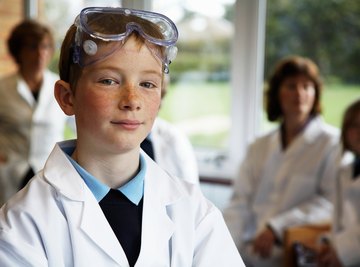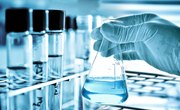
Borax, or sodium borate, is a powdered household cleaning product sold in most grocery stores, and it can be used in a number of science projects to demonstrate basic chemical principles. Fun projects for younger students use Borax to teach the basics about polymers and crystal formation, while more complex experiments combine borax with metals to demonstrate oxidization and ions to more advanced students. Borax is toxic if swallowed and is an irritant to the eyes. Young children should use borax only under adult supervision.
Borax Polymers
A polymer is a substance with long chains of connected identical molecules. To create a polymer, dissolve 1.5 tablespoons of Borax in 1 cup of warm water and mix with 2 cups of Elmer's glue and 2 more cups of hot water. This creates a putty-like material that can be manipulated to demonstrate how viscosity can change with the application of force. To create a bouncy ball and show how polymer networks can compress and spring back, add cornstarch to the mixture and follow the instructions laid out in the polymer lesson plan from BEAM: Berkeley Engineers and Mentors.
Borax Crystals
To show how crystals form by the process of recrystallization, fill a glass jar with hot, but not boiling, water and dissolve three tablespoons of Borax for each cup of water to create a supersaturated solution. Suspend a string in the solution, making sure it doesn't touch the sides of the jar, and leave it for at least five hours. As the water cools, it is less able to hold the Borax in solution, and some of it crystallizes on the string, forming molecules of interlocking patterns that repeat in an observable structure.
pH Comparisons
The pH scale measures from 1 to 9 how acidic or basic a substance is. To compare the pH of bases and acids, dip strips of pH paper into separate paper cups, one containing lemon juice and another a solution of 1/8 of a teaspoon of Borax and 1/4 cup of water. The lemon juice turns the pH paper red, while the Borax turns it blue. Compare the colors of the pH strips to a pH color chart to see that lemon juice is an acid with a pH of 2, and Borax as a base has a pH of 9.
The Borax Bead Test
For high school students, a more complex experiment uses Borax and a Bunsen burner to demonstrate properties of metal ions. Heat up a chrome-plated paperclip in the Bunsen burner flame and dip it into a pile of dry Borax powder. Return it to the flame and repeat several times until a glassy Borax bead forms on the wire. Dip the bead into water and then into a powdered sample of a metal ion, like copper or iron, and return to the flame. Students should repeat the experiment with several different metals and record their observations as the ion's electrons heat up and turn the Borax bead different colors.
References
About the Author
Taylor Echolls is an award-winning writer whose expertise includes health, environmental and LGBT journalism. He has written for the "Valley Citizen" newspaper, where his work won first- and second-place awards in sports and outdoor features from the Idaho Press Club. Echolls holds a B.A. from Mount Holyoke College.
Photo Credits
Ableimages/Digital Vision/Getty Images
